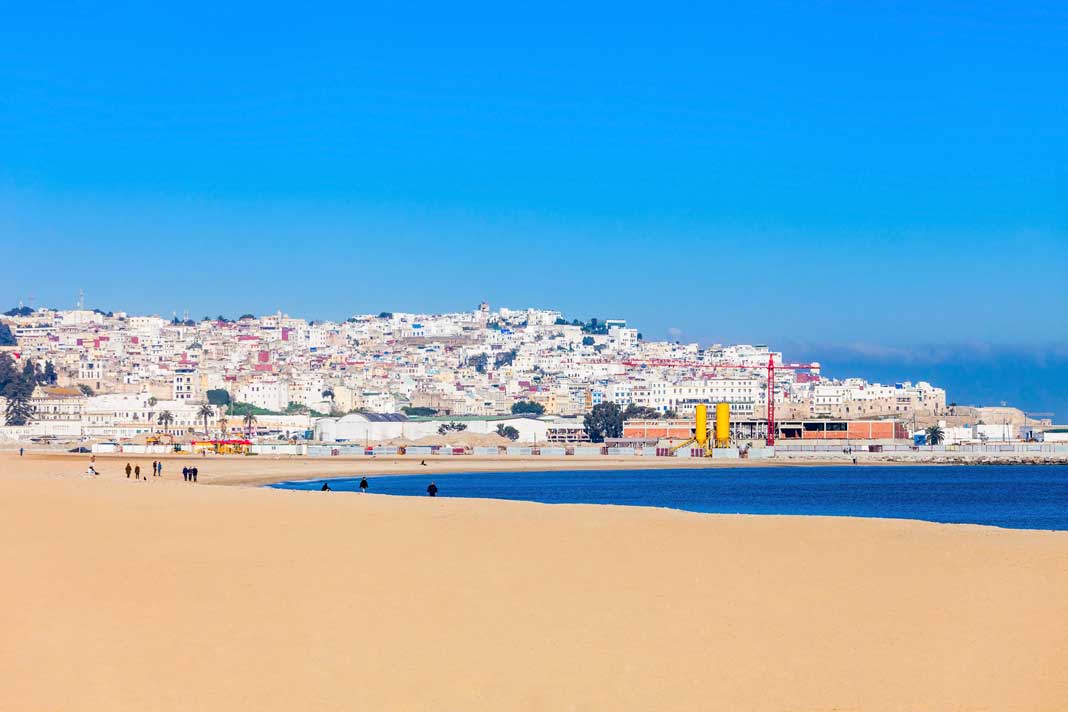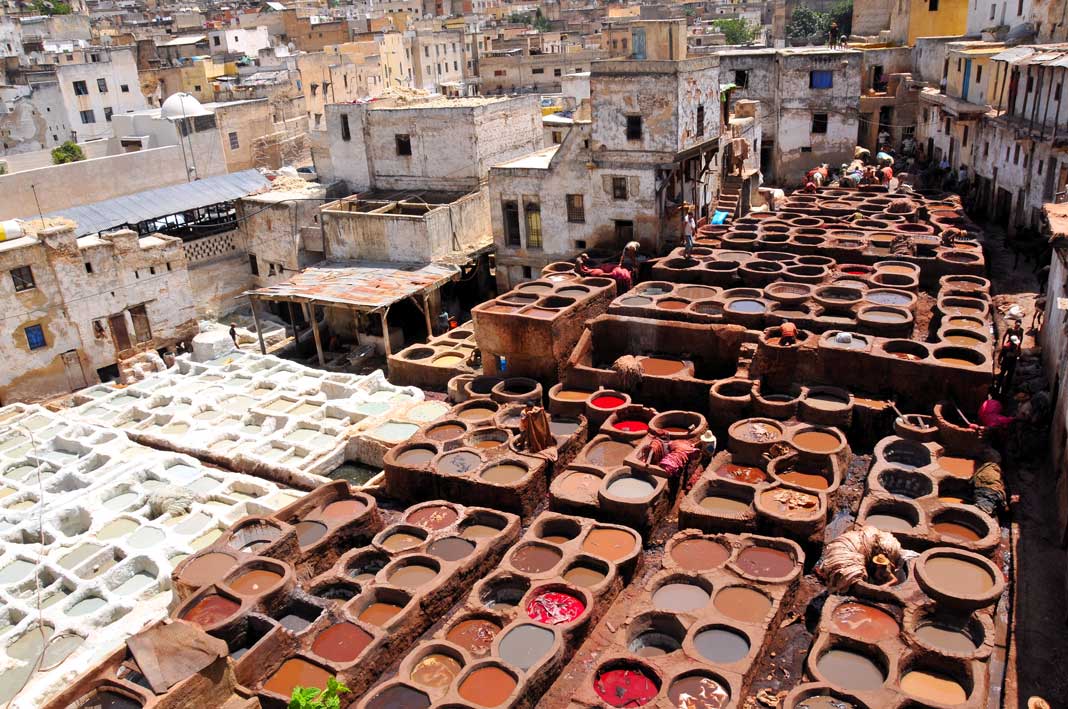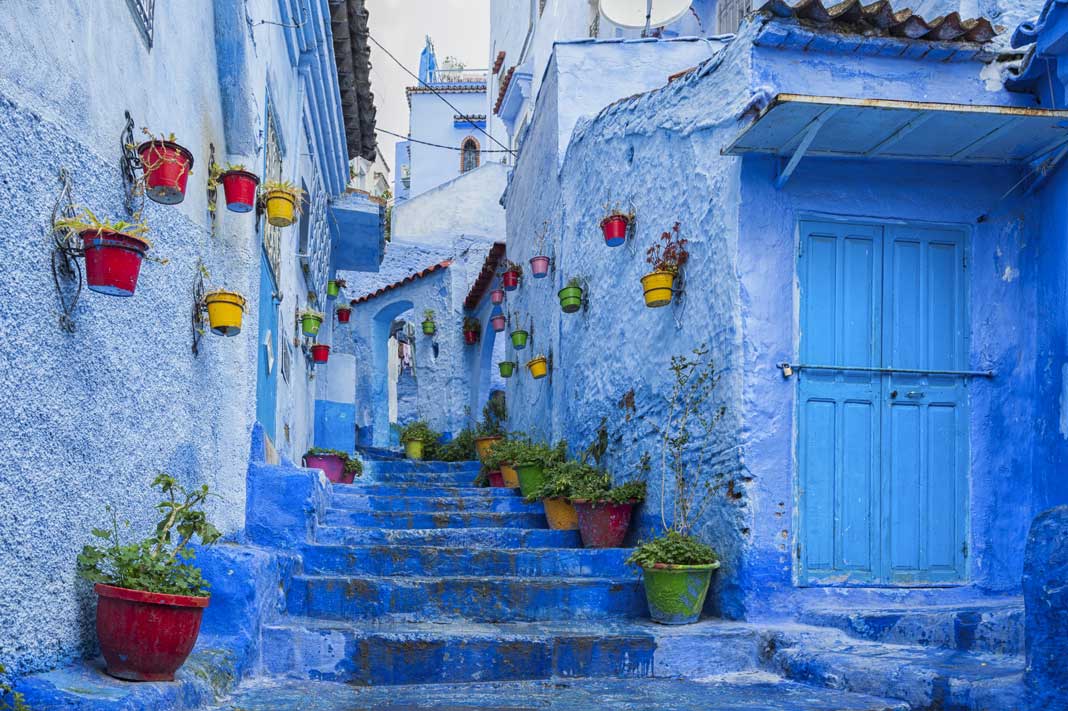Northern Morocco is full of color; the fruits and spices in the markets, the dyes of leather tanneries, the intricate carpets, the decorative tiles, hanging lamps, glass windows, patterned tagine bowls and beaded jewelry. There is a wonderful chaos to its streets and an enticing energy that the locals welcome you to discover. Be prepared to be welcomed. Moroccan people are very friendly, helpful and especially hospitable; offering food and mint tea and directions at every opportunity.
Table of Contents
Why Travel Northern Morocco?
At 446,550 km², Morocco is a huge country, deceivingly dwarfed by neighboring Algeria. Unless you plan to travel for several months, you cannot make the most of the whole country in a single trip. If you want to taste the culture on a limited timeline, consider traveling Northern Morocco. Here you have many great cities relatively close together, all offering its own local scene yet providing a general understanding of the national culture. There are many great places to explore. But our favorites are Tangier, Fez, and Chefchaouen.
Tangier
A coastal city in the very north of Morocco, Tangier acts as the gateway between Europe and Africa. It is a great first stop for those traveling from Spain, as a trip to Tarifa or Algeciras is only an hour ferry ride away. Tangier is the only place on our list with a beach. It’s a long one bordering the city and offering beautiful views over the water between Morocco and Spain. At night, you can even see the lights of Europe in the distance.

Like most Northern Moroccan cities, there is an extensive medina, or old town, in which to get lost. The Kasbah is the area with the most intricate streets and cobbled alleyways. By climbing upwards, you can find the historic doors and quiet squares that mark the entrances to the old town. Be sure to relax at the top and see the views of the Mediterranean stretch out into the distance.
If you are looking for cultural sites, there is the grand mosque, which was originally a fifth-century Roman temple. It marks the fascinating architecture of Morocco and stands for the Muslim culture of the country. It is a great experience to hear the call to prayer from mosques throughout the city, especially on one of the many rooftop terraces, when the sounds surround you.
Looking for a hostel in Tangier? Try Kasbah Hostel, a new place full of energy, based in a traditional Moroccan house and emerged deep within the historic center.
Fez
Fez is often known as the cultural capital of Morocco. Home to the oldest university in the world, containing one of the most preserved Arabic old towns and holding a 1,200-year-old history, it’s easy to see why. Off all three Northern Morocco cities, Fez is the most chaotic. It’s size, and popular markets make it a place of haggling voices, strong smells, and interesting sites; skewered camel heads, carpet carrying donkeys and an extensive array of sellable goods.

One thing you cannot avoid seeing in Fez are the tanneries. That’s because the locals will practically drag you to see them. Enter any leather shop on a collection of streets in the medina. At the top, terraces and balconies overlook the pits where they dye the leather. It’s free to enter, but the owners will pressure you to buy something. The smell is terrible, but the view is classic Fez and worth a picture.
Start at the bronze square, where local shop owners make their products in the street. Then take a path off to the right when heading towards the grand mosque. You can easily see the tannery shops along this street. Continue to pass many stores selling traditional carpets, Berber jewelry, antique crockery and Fez souvenirs. Just don’t expect to explore them quietly!
Although the medina is a pedestrian zone, and the largest car-free urban zone in the world, you can easily find taxis on the outskirts of the old town. Taxis are very cheap, and it’s worth using them to get to the other side of the medina; it’s neither easy, quick simple or peaceful to stroll back through the markets. It’s busy, bustling and a little crazy. Throw yourself into the chaos that is so natural to the locals.
Chefchaouen
No other Moroccan city is as colorful as Chefchaouen, also known as The Blue Pearl. Buried in the foothills of the Rif Mountains, this is an idyllic and beautiful destination of Northern Morocco. It is a favorite of tourists for a good reason. Unlike most tourist cities, they don’t swarm the town. Chefchaouen retains its charm in quaint streets and quiet squares and is a great place to get to know the local culture.

Chefchaouen is most famous for its blue painted buildings, found in the old town. These tranquil streets are a nice change from the chaos and hustle of Fez and Tangier. Shopkeepers are less pushy alleyways are quieter, and people are more chilled than in other cities. In some ways, it misses a bit of the typical Moroccan experience for that reason. But after the stress of bigger cities, it is a great counterweight; to stroll by the river, explore a peaceful market and slowly explore the medina.
Some say the blue walls reflect the sun. Others say they keep away mosquitos. Many stories surround the architecture, but one prevailing opinion is that the unique and captivating color scheme of the town is lovely. The cute streets, with lounging cats and colorful flowers, also make for great photos.
To escape the town and venture into those inviting mountains, journey to nearby Akchour, a group taxi ride away. From here, there is a hike into the mountains, along a river leading to some impressive waterfalls. You can choose either an hour hike to a small waterfall or three-hour hike to a larger one. Either way, you get to discover the beautiful nature of Northern Morocco and explore a new side to the country.
Transport
You can easily travel Northern Morocco by train, bus or car. Main roads journey between the major cities. They offer great scenic views of rural Moroccan, filled with tiny villages, shepherds, farms and a uniquely dry and dusty landscape. Trains are the faster but more expensive option. Buses are the most popular choice for travelers. CTM is the national service and the nicest option. But local buses are cheaper and have more regular times. They are however more chaotic, not as nice, and take as long as anyone’s guess – but they at least allow for some interesting travel stories.
Northern Morocco is a colorful and cultural area of the country. However, there are still so many other things to see and do in this wonderful place. Ride camels through the Sahara, sleep in tents on the outskirts of Merzouga, explore the medina of Marrakech and travel the famous western coastline from Casablanca to Rabat. Even when you explore some of amazing Northern Morocco, you will leave with a list of routes still left to follow and the strong desire to return in the future; captured by the magic of the country.



Wow, when I go back to Morocco, these are a must visit!
Thanks, Danielle 🙂 I agree! Looking forward to camel riding in the desert next time though!
Morocco looks beautiful place and you shared good information about that place. Its really enjoyable and stunning photos you shared Thank you so much for sharing your fantastic photos and wonderful experience here.